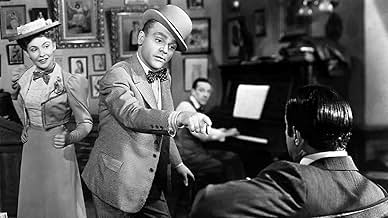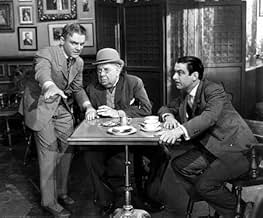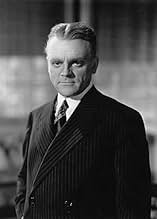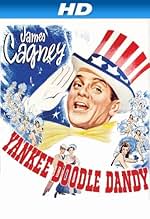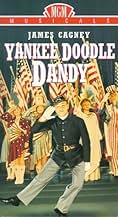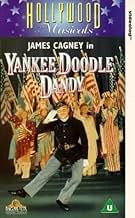ÉVALUATION IMDb
7,6/10
18 k
MA NOTE
La vie du célèbre compositeur musical, dramaturge, acteur, danseur et chanteur George M. Cohan.La vie du célèbre compositeur musical, dramaturge, acteur, danseur et chanteur George M. Cohan.La vie du célèbre compositeur musical, dramaturge, acteur, danseur et chanteur George M. Cohan.
- A remporté 3 oscars
- 9 victoires et 6 nominations au total
Patsy Parsons
- Josie Cohan - As a Girl of 12
- (as Patsy Lee Parsons)
Avis en vedette
`Yankee Doodle Dandy' makes the viewer say, `They don't make them like that anymore.' The film is uplifting for its espousal of unabashed patriotism and its representation of America as a place in which a gifted performer like George M. Cohan could rise from vaudeville to Broadway. It is also moving for its reverence for the nineteenth late century theatre and early twentieth century Broadway: the sequence showing Cohan's successes of the 1920s commemorate the other musical and non musical hits of the decade as much as Cohan's. I was moved to tears by the ending showing the elderly Cohan joining in a World War II parade, a group of soldiers marching to `Over There' and being asked why he isn't singing, `Hey old-timer, don't you know this song?' `Yankee Doodle Dandy' is a celebration of Cohan's life and career -- a little sanitised perhaps, but still portraying his love for his family, his profession and his country. It isn't a museum piece but more of a picture from another era and in a time when America is honoured by songs such as `Kick Ass USA' it's a valuable reminder of an age when people feeling their country under threat roused their nationalism by reminding themselves of what made them want to fight for it.
James Cagney won his only Oscar for his recreation of George M. Cohgan in Yankee Doodle Dandy. Already terminally ill, Cohan lived long enough to see the film and no doubt he would have approved of it because it sure is how he would like to have been remembered.
In 1942 when Yankee Doodle Dandy premiered there was a whole generations of people left alive who saw George M. Cohan perform. Watching the film today Cohan is like a figure from antiquity. But Warner Brothers was lucky to have James Cagney with the studio who's dancing style closely paralleled Cohan's. If it is ever run on Turner Classic Movies, make sure you see George M. Cohan's sound film The Phantom President. You will be astonished to see how closely Cagney captured his style. In the same way that Philip Seymour Hoffman captured Truman Capote and Joaquin Phoenix became Johnny Cash.
Cohan's contemporaries are also like names from antiquity. But a century ago when Cohan was just hitting the big time performers like Fay Templeton, Nora Bayes, and Eddie Foy were very big stars and in 1942 plenty of people saw them also. I wish we had some film of them to see how Irene Manning, Frances Langford, and Eddie Foy, Jr. did in their recreations. I'm sure Foy, Jr. did a smashing job with his Dad.
The background stuff is true enough. Cohan was born to a pair of vaudeville performers Jerry and Nellie Cohan played here by Walter Huston and Rosemary DeCamp. Later on a sister was added to the Cohan family and here Josie Cohan is played by Jeanne Cagney. They did do all the towns, big and small, in America. Cagney meets wife Joan Leslie at Shea's Theater in Buffalo, New York and Shea's survives to this day. And his first real success was Little Johnny Jones which score included American classics, Yankee Doodle Dandy and Give My Regards to Broadway.
What's left out is the fact Cohan had two wives. His second wife survived him and died in the early Seventies. As his songs became popular in patriotic/rightwing circles, Cohan's personal politics reflected that. He fought hard and lost in the battle for Actors Equity. Cohan thought a union of players was tantamount to Communism. But such was his standing among performers that Cohan was granted the unique privilege of being allowed to appear on stage without having to join Equity once the union was recognized as the bargaining agent for players.
Cohan is shown in Yankee Doodle Dandy as gracefully having retired when other trends in popular music took over. Far from it, he was a very bitter man and when he did that final comeback in I'd Rather Be Right he fought with Kaufman and Hart over the book and Rodgers and Hart over the songs.
But Yankee Doodle Dandy presents the public musical face of George M. Cohan and does it very well. To this day, some forty years after first seeing Yankee Doodle Dandy on television, I love the recreations of Yankee Doodle Dandy, Give My Regards to Broadway, and You're a Grand Old Flag as they were first seen on stage. Plus some of the snatches of the lesser known Cohan songs as performed by the players portraying the Cohan family and others.
When all is said and done, George M. Cohan was a great force of nature in the American musical theater. And we thank his father, mother, and sister, and George M. himself for what he left us.
In 1942 when Yankee Doodle Dandy premiered there was a whole generations of people left alive who saw George M. Cohan perform. Watching the film today Cohan is like a figure from antiquity. But Warner Brothers was lucky to have James Cagney with the studio who's dancing style closely paralleled Cohan's. If it is ever run on Turner Classic Movies, make sure you see George M. Cohan's sound film The Phantom President. You will be astonished to see how closely Cagney captured his style. In the same way that Philip Seymour Hoffman captured Truman Capote and Joaquin Phoenix became Johnny Cash.
Cohan's contemporaries are also like names from antiquity. But a century ago when Cohan was just hitting the big time performers like Fay Templeton, Nora Bayes, and Eddie Foy were very big stars and in 1942 plenty of people saw them also. I wish we had some film of them to see how Irene Manning, Frances Langford, and Eddie Foy, Jr. did in their recreations. I'm sure Foy, Jr. did a smashing job with his Dad.
The background stuff is true enough. Cohan was born to a pair of vaudeville performers Jerry and Nellie Cohan played here by Walter Huston and Rosemary DeCamp. Later on a sister was added to the Cohan family and here Josie Cohan is played by Jeanne Cagney. They did do all the towns, big and small, in America. Cagney meets wife Joan Leslie at Shea's Theater in Buffalo, New York and Shea's survives to this day. And his first real success was Little Johnny Jones which score included American classics, Yankee Doodle Dandy and Give My Regards to Broadway.
What's left out is the fact Cohan had two wives. His second wife survived him and died in the early Seventies. As his songs became popular in patriotic/rightwing circles, Cohan's personal politics reflected that. He fought hard and lost in the battle for Actors Equity. Cohan thought a union of players was tantamount to Communism. But such was his standing among performers that Cohan was granted the unique privilege of being allowed to appear on stage without having to join Equity once the union was recognized as the bargaining agent for players.
Cohan is shown in Yankee Doodle Dandy as gracefully having retired when other trends in popular music took over. Far from it, he was a very bitter man and when he did that final comeback in I'd Rather Be Right he fought with Kaufman and Hart over the book and Rodgers and Hart over the songs.
But Yankee Doodle Dandy presents the public musical face of George M. Cohan and does it very well. To this day, some forty years after first seeing Yankee Doodle Dandy on television, I love the recreations of Yankee Doodle Dandy, Give My Regards to Broadway, and You're a Grand Old Flag as they were first seen on stage. Plus some of the snatches of the lesser known Cohan songs as performed by the players portraying the Cohan family and others.
When all is said and done, George M. Cohan was a great force of nature in the American musical theater. And we thank his father, mother, and sister, and George M. himself for what he left us.
So it takes liberties with facts. So it's jingoistic. Big deal! I adore it for its depiction of turn-of-the-(20th}century New York, especially its theater, which has fascinated me for years. And it has the breath-taking performance of Jimmy Cagney in the title role; he's absolutely elecrifying in the musical numbers. If some scenes are mawkish, well, I think that can be forgiven.
This movie, above all others, make me so proud to be an American.
This movie, above all others, make me so proud to be an American.
10lugonian
YANKEE DOODLE DANDY (Warner Brothers, 1942), directed by Michael Curtiz, is an autobiographical musical of a legendary Broadway showman, composer, actor and dancer, George M. Cohan (1878-1942), as played by James Cagney in what's been reported as his personal favorite of all movie roles, and it's easy to see why. In spite the fact that Cagney won his only Academy Award as best actor, he was letter perfect in the role as Cohan. Interesting to see a noted movie tough guy singing and dancing, but it's even more-so in watching Walter Huston as Cohan's father doing a song and dance himself.
The story opens with the middle-aged Cohan (James Cagney), following a comical musical performance in "I'd Rather Be Right" in which he plays and spoofs the president (Franklin D. Roosevelt). He gets a telegram from the president himself to meet with him at the White House. Believing the worst, he arrives to meet "with the head man." Alone with him in the Oval Office, the two men converse which leads to Cohan to soon be relating his life story via flashback starting with his birth (born on the 4th of July), as the son of stage entertainers, Jerry and Nellie Cohan (Walter Huston and Rosemary DeCamp), followed by his boyhood days as the star of "Peck's Bad Boy" (Douglas Croft playing George at age 12), the teaming up with his younger sister, Josie (first played by JoAnn Marlowe, then by Patsy Lee Parsons, and by Jeanne Cagney as an adult) and his parents, forming the act called "The Four Cohans," George leaving the family to form an act on his own, his association with a young hopeful named Mary (Joan Leslie), whom he eventually marries, the publication of his songs that make him world famous, the death of his parents, his retirement from the stage and his return to Broadway to appear in a play that has summoned him with an invitation from the president, and after nearly two hours of recollection, the story moves forward to present day with Cohan to find out why he was really asked to come to visit with the president.
With a handful of song and dance tunes, many composed by Cohan himself, the soundtrack is as follows: "The Dancing Master," "The Dancing Master" (reprise); "Strolling Through the Park One Day" (by Joe Goodwin and Gus Edwards); "Minstrel Number," "I Was Born in Virginia," "The Warmest Baby in the Bunch," "Harrigan," "Yankee Doodle Dandy," "Yankee Doodle Dandy," "All Aboard for Old Broadway" (by Jack Scholl and M.K. Jerome), "Give My Regards to Broadway," "Oh, You Wonderful Girl," "Blue Skies, Grey Skies," "The Barber's Ball," "Mary," "Forty-Five Minutes From Broadway," "Mary" (reprise); "Forty-Five Minutes From Broadway," "So Long, Mary," "You're a Grand Old Flag," "Battle Hymn of the Republic" (by William Steffe and Julia Ward Howe); "When Johnny Comes Marching Home," "Of Thee I Sing," "You're a Grand Old Flag," "Come Along With Me," "Over There," "I'm Happy As Can Be," "Love Nest" (by Louis A. Hirsch and Otto Harbach); "Little Nellie Kelly," "The Man Who Owns Broadway," "Molly Malone," "Billie," "Jeepers Creepers" (by Johnny Mercer and Harry Warren); "Off the Record" and "Over There." Of the songs listed above, several could have been chosen as alternate titles in regards to Cohan, including: "Give My Regards to Broadway," "Grand Old Flag," "The Man Who Owns Broadway," or "Off the Record," but the final selection became "Yankee Doodle Dandy." While many of these songs are Broadway show tunes, the most memorable ones happen to be the patriotic songs, especially "Grand Old Flag," "Over There," and of course, the title tune.
In the supporting cast are Irene Manning (Fay Templeton); Richard Wholf (Samuel H. Harris); George Tobias (Mr. Dietz); George Barbier (Claude Erlanger); S.Z. Sakall (Mr. Schwab); Eddie Foy Jr. (Eddie Foy); Minor Watson (Edward Albee); and Frances Langford credited as a singer, but actually Nora Bayes. Listed bottom in the cast is Captain Jack Young as The President, who, during the opening and closing segments, is only visible by a back-view depiction.
YANKEE DOODLE DANDY started a new trend of bio-musicals that would become fashionable throughout the 1940s. As a movie, YANKEE DOODLE DANDY is a grand old musical that blends nostalgia of the past (early twentieth century, World War I) with patriotism of the 1940s. While very little is known of the real George M. Cohan today, the inaccuracies wouldn't really matter nor noticed. Cohan was actually married twice, but never to a girl named Mary. The screenplay, overall, fails to mention Cohan actually appeared in some motion pictures, one being THE PHANTOM PRESIDENT (Paramount, 1932) opposite Claudette Colbert. To watch that Cohan film is to see how close Cagney worked to impersonate him on screen. YANKEE DOODLE DANDY is true indication of Cagney not just as a movie tough guy, but his diversatility as an actor. Although the patriotism plays towards the World War II audience, much of Cohan's spirit of being an American continues to reflect upon the present generation.
Full of memorable lines, YANKEE DOODLE DANDY's most noted happens to be Cohan's closing speech following a performance, "My father thanks you, my mother thanks you, my sister thanks you, and I THANK YOU." Filmed with crisp black and white photography, YANKEE DOODLE DANDY did go through the process of colorization in the mid 1980s. While original Technicolor photography might have been its major asset, YANKEE DOODLE DANDY still ranks first rate entertainment for all ages, and one responsible in keeping the George M. Cohan name more alive today than ever before. Available on video cassette, DVD and through presentations on Turner Classic Movies. (**** flags)
The story opens with the middle-aged Cohan (James Cagney), following a comical musical performance in "I'd Rather Be Right" in which he plays and spoofs the president (Franklin D. Roosevelt). He gets a telegram from the president himself to meet with him at the White House. Believing the worst, he arrives to meet "with the head man." Alone with him in the Oval Office, the two men converse which leads to Cohan to soon be relating his life story via flashback starting with his birth (born on the 4th of July), as the son of stage entertainers, Jerry and Nellie Cohan (Walter Huston and Rosemary DeCamp), followed by his boyhood days as the star of "Peck's Bad Boy" (Douglas Croft playing George at age 12), the teaming up with his younger sister, Josie (first played by JoAnn Marlowe, then by Patsy Lee Parsons, and by Jeanne Cagney as an adult) and his parents, forming the act called "The Four Cohans," George leaving the family to form an act on his own, his association with a young hopeful named Mary (Joan Leslie), whom he eventually marries, the publication of his songs that make him world famous, the death of his parents, his retirement from the stage and his return to Broadway to appear in a play that has summoned him with an invitation from the president, and after nearly two hours of recollection, the story moves forward to present day with Cohan to find out why he was really asked to come to visit with the president.
With a handful of song and dance tunes, many composed by Cohan himself, the soundtrack is as follows: "The Dancing Master," "The Dancing Master" (reprise); "Strolling Through the Park One Day" (by Joe Goodwin and Gus Edwards); "Minstrel Number," "I Was Born in Virginia," "The Warmest Baby in the Bunch," "Harrigan," "Yankee Doodle Dandy," "Yankee Doodle Dandy," "All Aboard for Old Broadway" (by Jack Scholl and M.K. Jerome), "Give My Regards to Broadway," "Oh, You Wonderful Girl," "Blue Skies, Grey Skies," "The Barber's Ball," "Mary," "Forty-Five Minutes From Broadway," "Mary" (reprise); "Forty-Five Minutes From Broadway," "So Long, Mary," "You're a Grand Old Flag," "Battle Hymn of the Republic" (by William Steffe and Julia Ward Howe); "When Johnny Comes Marching Home," "Of Thee I Sing," "You're a Grand Old Flag," "Come Along With Me," "Over There," "I'm Happy As Can Be," "Love Nest" (by Louis A. Hirsch and Otto Harbach); "Little Nellie Kelly," "The Man Who Owns Broadway," "Molly Malone," "Billie," "Jeepers Creepers" (by Johnny Mercer and Harry Warren); "Off the Record" and "Over There." Of the songs listed above, several could have been chosen as alternate titles in regards to Cohan, including: "Give My Regards to Broadway," "Grand Old Flag," "The Man Who Owns Broadway," or "Off the Record," but the final selection became "Yankee Doodle Dandy." While many of these songs are Broadway show tunes, the most memorable ones happen to be the patriotic songs, especially "Grand Old Flag," "Over There," and of course, the title tune.
In the supporting cast are Irene Manning (Fay Templeton); Richard Wholf (Samuel H. Harris); George Tobias (Mr. Dietz); George Barbier (Claude Erlanger); S.Z. Sakall (Mr. Schwab); Eddie Foy Jr. (Eddie Foy); Minor Watson (Edward Albee); and Frances Langford credited as a singer, but actually Nora Bayes. Listed bottom in the cast is Captain Jack Young as The President, who, during the opening and closing segments, is only visible by a back-view depiction.
YANKEE DOODLE DANDY started a new trend of bio-musicals that would become fashionable throughout the 1940s. As a movie, YANKEE DOODLE DANDY is a grand old musical that blends nostalgia of the past (early twentieth century, World War I) with patriotism of the 1940s. While very little is known of the real George M. Cohan today, the inaccuracies wouldn't really matter nor noticed. Cohan was actually married twice, but never to a girl named Mary. The screenplay, overall, fails to mention Cohan actually appeared in some motion pictures, one being THE PHANTOM PRESIDENT (Paramount, 1932) opposite Claudette Colbert. To watch that Cohan film is to see how close Cagney worked to impersonate him on screen. YANKEE DOODLE DANDY is true indication of Cagney not just as a movie tough guy, but his diversatility as an actor. Although the patriotism plays towards the World War II audience, much of Cohan's spirit of being an American continues to reflect upon the present generation.
Full of memorable lines, YANKEE DOODLE DANDY's most noted happens to be Cohan's closing speech following a performance, "My father thanks you, my mother thanks you, my sister thanks you, and I THANK YOU." Filmed with crisp black and white photography, YANKEE DOODLE DANDY did go through the process of colorization in the mid 1980s. While original Technicolor photography might have been its major asset, YANKEE DOODLE DANDY still ranks first rate entertainment for all ages, and one responsible in keeping the George M. Cohan name more alive today than ever before. Available on video cassette, DVD and through presentations on Turner Classic Movies. (**** flags)
The amazing piece of timing here is when Warner Bros. began work on this biography of entertainer George M. Cohan, WWII had not yet broken out. The attack on Pearl Harbor occurred the day before shooting began. When the film opened people on the home front badly needed some morale boosting, and this film gave it to them. It's just a joyous musical costume piece from start to finish with nice comic touches balanced with some sentimental moments (supposedly Walter Huston's deathbed scene had even taskmaster director Michael Curtiz crying). There's nothing in the way of real conflict or even much heavy in the way of romance between Cohan and his fictitious film wife "Mary", who was modeled after Cohan's actual second wife in some ways. Cohan was actually married twice. Oddly enough, it was Cohan who said he wanted as little romance in the film as possible.
The more I learn about Cohan the more I realize that Cagney was perfect to play him - both Irish Americans, both about the same size and build, and George Cohan's style of dancing and singing were about the same as Cagney's. It's hard to believe that Fred Astaire was Cohan's first choice to play himself. Astaire was a great talent, but I don't think he could have conveyed the combination of mischief, optimism and energy that was Cohan the way that Cagney ultimately did. Several people criticize Cagney's dancing here, but that eccentric style was Cohan's, who always considered himself more of an overall entertainer than a dancer in the first place.
If you're "date conscious" as I am, there are some matters of plot that might bother you. Cohan was born on July 2 or 3, not July 4. Cohan's mother outlived his father by eleven years and Cohan's father was not "very old" when he died as is said in the film - at least by today's standards. When Cohan's father died in 1917, he was only 69. Cohan's sister did die young - she was only 39, dying in 1916, plus she was not his little sister. Instead Josie was a year older than George. The film has Josie marrying when she would have been close to forty, when she actually married at the beginning of the 20th century and thus was the one to break up the four Cohans, not George. Also, Cohan received his Congressional Medal in 1936, not as WWII began as shown in the film. However the plot device of having George M. recount his life story to FDR, receiving his Congressional medal in the Oval Office, and then dance joyously down the White House stairs and into the streets joining a group of marching soldiers in a chorus of "Over There" was probably a great way to bridge Cohan's patriotic past with what was then an uncertain time that certainly needed a dose of his optimism.
The one thing that I did find a little odd - and one thing isn't much in a two plus hour long movie - is that it is hard to spot the actual point in the film where Mary becomes George's wife. There is quite a bit of domesticity shown before the two were married. Mary is cooking for George, staying in his apartment alone waiting for him to come home from the show, and acting very much like they are already married. The only way you know they are not is that George very subtly pops the question to the point that I'm surprised even Mary knew what he was asking! I know this doesn't seem like much in today's world, but considering that they were trying to paint Cohan in the most positive light possible and that the living arrangements might be misunderstood, I am surprised that the censors of that time never raised the issue.
At any rate, I highly recommend this one. You'll have a great time, at least in part because you can see that Cagney is having a great time. He always said this film was his favorite, and it shows in his performance.
The more I learn about Cohan the more I realize that Cagney was perfect to play him - both Irish Americans, both about the same size and build, and George Cohan's style of dancing and singing were about the same as Cagney's. It's hard to believe that Fred Astaire was Cohan's first choice to play himself. Astaire was a great talent, but I don't think he could have conveyed the combination of mischief, optimism and energy that was Cohan the way that Cagney ultimately did. Several people criticize Cagney's dancing here, but that eccentric style was Cohan's, who always considered himself more of an overall entertainer than a dancer in the first place.
If you're "date conscious" as I am, there are some matters of plot that might bother you. Cohan was born on July 2 or 3, not July 4. Cohan's mother outlived his father by eleven years and Cohan's father was not "very old" when he died as is said in the film - at least by today's standards. When Cohan's father died in 1917, he was only 69. Cohan's sister did die young - she was only 39, dying in 1916, plus she was not his little sister. Instead Josie was a year older than George. The film has Josie marrying when she would have been close to forty, when she actually married at the beginning of the 20th century and thus was the one to break up the four Cohans, not George. Also, Cohan received his Congressional Medal in 1936, not as WWII began as shown in the film. However the plot device of having George M. recount his life story to FDR, receiving his Congressional medal in the Oval Office, and then dance joyously down the White House stairs and into the streets joining a group of marching soldiers in a chorus of "Over There" was probably a great way to bridge Cohan's patriotic past with what was then an uncertain time that certainly needed a dose of his optimism.
The one thing that I did find a little odd - and one thing isn't much in a two plus hour long movie - is that it is hard to spot the actual point in the film where Mary becomes George's wife. There is quite a bit of domesticity shown before the two were married. Mary is cooking for George, staying in his apartment alone waiting for him to come home from the show, and acting very much like they are already married. The only way you know they are not is that George very subtly pops the question to the point that I'm surprised even Mary knew what he was asking! I know this doesn't seem like much in today's world, but considering that they were trying to paint Cohan in the most positive light possible and that the living arrangements might be misunderstood, I am surprised that the censors of that time never raised the issue.
At any rate, I highly recommend this one. You'll have a great time, at least in part because you can see that Cagney is having a great time. He always said this film was his favorite, and it shows in his performance.
Le saviez-vous
- AnecdotesMany facts were changed or ignored to add to the feel of the movie. For example, the real George M. Cohan was married twice, and although his second wife's middle name was Mary, she went by her first name, Agnes. In fact, the movie deviated from the truth to such a degree that Cohan's daughter Georgette commented, "That's the kind of life Daddy would have liked to have lived."
- GaffesThe "You're A Grand Old Flag" number, supposedly takes place in the 1906 production of "George Washington Jr.," and uses multiple period flags to represent times before 1906. The Civil War flag, as an example, is correct for the time in question. However, in the final sequence characters carry, and an soft screen projection is made of, multiple 48 star flags. The 48 star flag was not introduced until 1912. In 1906, it should have been a 45 star flag. (Oklahoma was admitted to the Union in 1907, New Mexico and Arizona in 1912).
- Citations
George M. Cohan: My mother thanks you, my father thanks you, my sister thanks you, and I thank you.
- Autres versionsAlso available in a computer colorized version.
- ConnexionsFeatured in The Voice That Thrilled the World (1943)
- Bandes originalesThe Yankee Doodle Boy
(1904) (uncredited)
from the Broadway Show "Little Johnny Jones"
Written by George M. Cohan
Played during the opening credits
Sung and Danced by James Cagney and Chorus
Meilleurs choix
Connectez-vous pour évaluer et surveiller les recommandations personnalisées
- How long is Yankee Doodle Dandy?Propulsé par Alexa
Détails
- Date de sortie
- Pays d’origine
- Langue
- Aussi connu sous le nom de
- Yankee Doodle Dandy
- Lieux de tournage
- société de production
- Consultez plus de crédits d'entreprise sur IMDbPro
Box-office
- Brut – États-Unis et Canada
- 11 800 000 $ US
- Durée2 heures 6 minutes
- Couleur
- Rapport de forme
- 1.37 : 1
Contribuer à cette page
Suggérer une modification ou ajouter du contenu manquant




